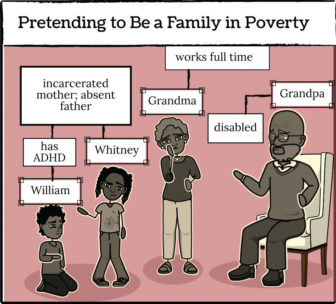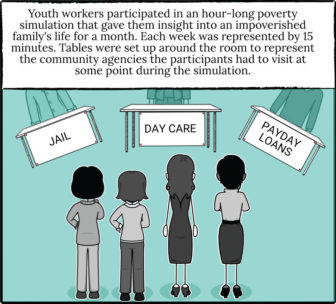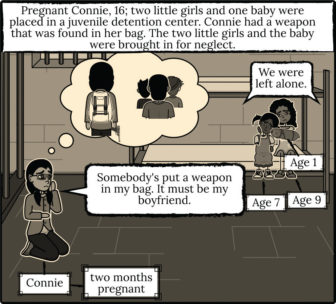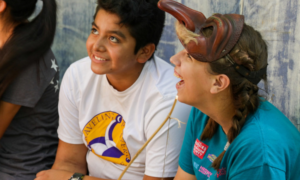At the National Youth-At-Risk Conference held in Savannah, Georgia, last spring, 82 youth workers and educators signed up to see if they could survive for one month living in poverty.
The hourlong simulation, facilitated by Aviva Goelman Rice, professional learning social studies coach with Savannah-Chatham public schools, gave participants a glimpse of what many of the young people and families they serve face each month.
Rice’s school system purchased two simulation kits from the Missouri Association for Community Action, and runs simulations for the district’s schools and some community agencies.
Approximately 15 million U.S. kids under age 18 (21 percent) are growing up in families with incomes below the federal poverty threshold, according to a 2014 report by the National Center for Children in Poverty. The center estimates families actually need income twice the federal poverty level in order to survive, thus estimating 44 percent of U.S. kids live in low-income families.
Families in this simulation typify a majority of low-income homes, based on average family income across the country.
“Poverty is not a game,” Rice began.
Participants sat in small groups, which represent their “family.” Each family opened a manilla envelope to find their sources of income, resources and bills, ID cards and transportation passes, representing the costs of real-life transportation. “Transportation is one of most critical resources for families, especially those living in poverty,” Rice told the group.
Each family has “the same goal as every family everywhere: Go to work every day, keep your family fed, keep your lights on …” instructed Rice. The simulation is organized into four 15-minute “weeks”.

Photos by Storyboard That
.
Week One:
A 13-year-old who tries to get day care services for a younger child is told to go to school. At the overcrowded school, children completed worksheets and were put down by teachers. “No one asked how are you doing,” said one participant in the debrief. “When the teacher said I needed $3 at school, it didn’t seem like a lot until I literally had no money to give.”
Juvenile detention already houses four kids: a 16-year old arrested for having a gun in her backpack, and three young children who’d been left at home alone and were picked up for neglect.
“It’s the weekend. Did you get everything done this week that you needed to get done?” the facilitator asks. The crowd moans a resounding “noooo.”
Service providers around the room share their offerings — from Quick Cash, a place to pay title loans, get payday loans and cash checks, to the mortgage company (whose representative says menacingly: “Very few people did that this week. So this week we’ll be coming to you.”). The social services group offers paperwork for investigating needs, and the homeless shelter is full.
The public school representative reminds families: “We’re going to need you all to make sure your child prior to coming to school has the supplies they need … Your child will need money for a field trip. And we’ll be closed the third week.”
There’s a bank, an employer (“I have one job vacancy open per week. Please make sure you have transportation passes. There is no talking on the job.”), the police, utility company, grocery store and a pawn shop.
 Week Two:
Week Two:
In one family, Grandpa stays home and pays the rent with his disability check when the mortgage company comes calling. Grandma gets $10 from the community services center along with emergency food and utility vouchers. When the kids come home from school, they share good grades on their report cards, but the granddaughter said she got suspended because she didn’t have a pencil. Grandma is exasperated: She’d gone to get transportation to get vouchers — and had to miss work.
People got evicted from their homes. Not everyone ate.
Week Three:
School is closed and “children have to be supervised,” the facilitator reminds, “or they’ll end up with an officer and in foster care.”
The kids stay home with Grandpa. Work is closed when Grandma arrives, so she goes to the pawn shop — which has lines six people deep to sell the stereo, TV, camera and furniture to pay the utilities and get more food. One of the kids asks if she needs to sell her shoes. One child has a $5 voucher for doing well at school.
Several more families have had their chairs turned over, representing eviction, and must go to the homeless shelter.
 Week Four:
Week Four:
Families have five minutes to plan for this last week. They have to buy food or risk getting system-involved for not providing nutrients for their children. Grandma has to get to work. Grandpa, with limited mobility, will go to the grocery store and the utility company. They rush off to their various tasks. The line at the employer is a dozen deep, but Grandma is first in line.
“We made it,” Grandma says at the end of the week, “but we didn’t eat for two weeks, and I missed work for two weeks. My employer said I was close to being fired. We were lucky we didn’t have a crisis or emergency (like a roof leak); we wouldn’t have made it.”
Debrief
In a huge circle around the room, the educators and youth workers debrief. “This has been real,” someone begins.
How many families kept the lights on? About half the hands go up.
How many families bought the required food each week? Most stay down.
Six families went without food the whole month.
“I was just thinking about our kids — the meals they get at school are the only meals they have during the day, or the snack after school. We went three weeks without food [in the game] — imagine one day,” says one participant.
The group applies their experience here to the work they do every day:
“They’re in survival mode, always trying to make ends meet — and the system is working against them.”
“I started thinking of strategies in the mindset of someone who’s poor: What can I sell, what can I hustle? Let me barter with you.”
“We’ve got to change some policies.”
“This was an eye-opener for me. One student told me, ‘You don’t know what I deal with at home.’ … Now after this, it makes me look through a different lens as I deal with students, a perfect storm for depression.”
“Poverty is the big issue in the neighborhood. What I see even more now besides the poverty that is clearly in my face, is all the trauma that my kids suffer,” sums up one participant. “So, here I am to learn all that I can to have a better understanding, and make it make sense.”
Click here for more videos from Youth Today































